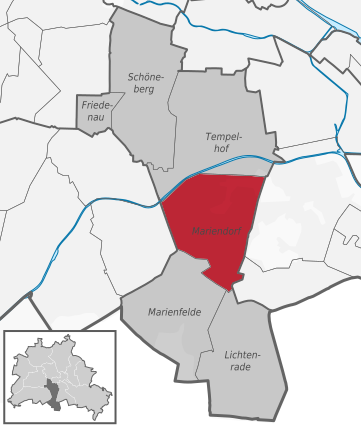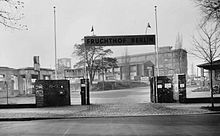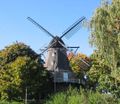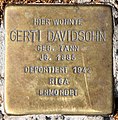Berlin-Mariendorf
|
Mariendorf district of Berlin |
|
|---|---|
| Coordinates | 52 ° 26 '24 " N , 13 ° 23' 24" E |
| surface | 9.38 km² |
| Residents | 53,094 (Dec. 31, 2019) |
| Population density | 5660 inhabitants / km² |
| Incorporation | Oct. 1, 1920 |
| Postcodes | 12105, 12107, 12109 |
| District number | 0704 |
| Administrative district | Tempelhof-Schöneberg |
Mariendorf is a district in the Tempelhof-Schöneberg district of Berlin , in the south of the city. Mariendorf is known nationwide mainly for its harness racing track . Mariendorf, together with the neighboring district of Marienfelde, is a foundation of the Knights Templar based in the Komturhof Tempelhof .
geography
location
The medieval village of Mariendorf was built on the Teltow plateau south of the Spree Valley (about 35 meters) , at an average height of about 50 meters. In the Middle Ages, the border to the Tempelhof district to the north was formed by a chain of puddles as melt remnants of the ice age ground moraine . This channel was used from 1900 to 1906 to build the Teltow Canal . One of these ice age pools was used as a seaside resort in Mariendorf until 1953 and then filled in. The Volkspark Mariendorf with its ponds has the same geological origin. However, the toboggan hill there is an artificial embankment.
The district of Mariendorf is located on the federal highway 96 between the northern district of Tempelhof (towards the city center) and the southern districts of Marienfelde and Lichtenrade (towards Teltow ).
The border of the district runs in the northwest along the Teltow Canal , inaugurated in 1906 ; the areas to the north of the former medieval district (including the Marienhöhe and the former Mariendorf S-Bahn station, today: Attilastraße ) were assigned to the Tempelhof district in 1938 for administrative reasons. Shortly before Mariendorfer Damm , it jumps to Ullsteinstraße 150 and continues on it towards the east. From Gottlieb-Dunkel-Straße , the border runs along the northern edge of St.-Michael-Kirchhof to junction 22 - Gradestraße of federal motorway 100 . From this point the eastern district boundary runs together with the district boundary through various allotment garden areas in a southerly direction, reaches the transition from Britzer Straße to Mohriner Allee, continues parallel to Hochkönigweg and to the confluence of Tauernallee / Quarzweg. From this point the Ankogelweg and the eastern property boundary of the indoor and outdoor swimming pool of the same name form the boundary to Mariendorfer Damm. The district boundary jumps to the west side of the dam and then follows the Föttinger line and Daimlerstraße to Titlisweg. Now the Marienfeld industrial area with the Daimlerwerk , the R. Stock AG and the Fritz-Werner-Werk - bounded by Titlisweg, Hirzerweg and Untertürkheimer Strasse (including the extended Untertürkheimer Strasse) - forms the border to the route of the Dresdener Bahn . The railway line forms the western boundary of the district up to the Teltow Canal.
The main traffic axis of Mariendorf is the Mariendorfer Damm (formerly: Chausseestrasse ) in the train of the B 96. It provides the connection between the center of Berlin and the Tempelhof district in the north and with the Lichtenrade district and further with Mahlow and Zossen in the south. A second transport corridor leads to the Lankwitzer road from the western Lankwitz (from Steglitz ) over the Britzer road to the easterly Britz (direction Neukölln ). The axes intersect with other roads in Alt-Marie village, where - in a way traffic busy ring road - a total of eight outgoing main roads are connected. This is also where the federal highway 101 begins in the direction of Marienfelde, Großbeeren , Trebbin and Jüterbog .
Settlement structure
Mariendorf today has largely closed residential developments in the northern part and in the center of Alt-Mariendorf . In terms of urban planning, apart from the Wilhelminian style old buildings, the large residential complexes and settlements built by the Berlin housing cooperatives or the now privatized housing associations such as GAGFAH or GEHAG in the 1930s as well as in the 1950s and 1960s .
To the south of the town center, two- to four-story residential buildings built after 1950 are arranged along the B 96, otherwise there are largely open single houses. With the exception of the former gasworks site, commercial and industrial areas are only found to a lesser extent in the actual Mariendorf , but in the adjacent areas of the districts of Tempelhof (especially on the Teltow Canal) and Marienfelde (especially the Daimler plant). Until the 1950s, extensive arable land stretched on both sides of the B 96 between the town centers of Alt-Mariendorf and Alt-Lichtenrade, with the exception of the Mariendorf trotting track, which opened in 1913, the Daheim settlement built from 1919 and the Adlermühle from 1899.
history
From the beginning of the 13th to the end of the 19th century

Mariendorf was founded in the first half of the 13th century (probably around 1230) by the Knights Templar as a broad street village , as a branch village to the Komturhof Tempelhof . The village church of Mariendorf was built in the second quarter of the 13th century. In 1318 the Order of St. John became the legal successor of the dissolved Knights Templar on the Teltow . The first mention of Mariendorf as Mergendorp is documented in a document from 1348. In the land book of Charles IV (1375) Mariendorf was mentioned as Margendorpe / Margendorff / Mariendorff with 48 hooves owned by the Order of St. John (cruciferi ordini sancti Johannis) , including three parish hooves. Three kossats were mentioned . Tempelhof, Marienfelde and Mariendorf were sold to Berlin and the sister city of Cölln in 1435 by the Johanniter Knights. In 1448 the services of the peasants were transferred to the electoral office of Mühlenhof . In 1450 the place was apparently measured: There were now only 47 hooves: in addition to the three parish hooves, there was now also a church hoof. In the meantime a jug had also been made in the village . Only in 1591 was a “ free school ” mentioned.
The Reformation was introduced around 1539/1540. In 1590 Berlin sold its share in the villages of Tempelhof, Marienfelde and Mariendorf to Cölln.
In 1611 the plague raged in Mariendorf and from 1630 to 1648 the Thirty Years' War , during which the plague returned several times. The church tower got its wooden structure in 1737, which has been preserved until today. In the fire of July 13th, 1748, the south side from the church to the Dorfkrug burned down. The peasant liberation in the course of the Stein-Hardenberg reforms took place in 1807. The road from Berlin to Dresden through Mariendorf was completed in 1838. The village street was paved in 1864. Two puddles were filled in. In 1872 the villa colony Südende (part of Mariendorf until 1920) was founded and a new schoolhouse was built at the same time. In 1887 the horse-drawn tram between Hallescher Tor and Tempelhof was extended to Mariendorf, and in 1888 the Adlermühle was built . The Mariendorf station on the Dresdener Bahn (today: Attilastraße S-Bahn station ) was opened in 1895.
20th century
From 1903 to 1905 the Mariendorf town hall was built on Kaiserstraße and the adjacent street was named Rathausstraße . The town hall was in the Second World War in a raid by the Allies on Berlin destroyed during the night of 23 to 24 August 1943 bombs and the rubble in 1949 demolished. In 1911 the Realgymnasium Mariendorf planned by the architects' firm Reinhardt & Süßenguth (named after Hugo Eckener as Eckener-Gymnasium since 1930 ) moved to its location opposite the town hall on the corner of Kaiserstraße and Rathausstraße. In 1912–1913, the fire station was built according to plans by official building officer W. Gerbens and the police service building at Rathausstrasse 70-72 and in 1913 the Public Lyceum Berlin-Mariendorf, also planned by the architects Reinhardt and Süßenguth, opened as a girls' secondary school (in the building of today's Johanna Eck School , meanwhile Dag Hammarskjöld secondary school ) on Ringstrasse its gates; from 1937 to 1953, with a short interruption after the Second World War, it was called the Gertrud Stauffacher School . Between 1911 and 1919, Rosa Luxemburg lived at Lindenstrasse 2 (today: Biberacher Weg) in Südende, which belonged to Mariendorf until 1920, until she was murdered. With Hugo Eberlein was another very prominent USPD , Spartacus League and KPD -Gründungsmitglied in Mariendorf active, there is a tradition of his speech on 19 November 1918 during the brief seizure of power by the workers 'and soldiers' councils in the November Revolution .
The Mariendorf Trabrennbahn opened its operations in 1913. The first long high-voltage overhead line in Germany, built in 1918, led from the Zschornewitz power plant to Rummelsburg (today the location of the Klingenberg power plant ) on the southern edge of Mariendorf (on the southern edge of today's Ankogelbad on the extended route of - later named after - Hochspannungsweges in Neukölln ) to support the aluminum production caused by the war .
Construction began on the garden city settlement Daheim east of the Mariendorf trotting track in 1919. A year later, Tempelhof, Mariendorf, Marienfelde and Lichtenrade were incorporated into Berlin. The communities now formed the 13th Tempelhof district of Greater Berlin . The Mariendorf district of Südende was separated and became part of the Steglitz district .
On behalf of the Deutsche Bank the architect emerged 1929-1930 a residential complex in the Tauernallee after plans Hans Jessen under since the 1980s listed building stands.
The Volkspark Mariendorf developed in 1923 and was officially inaugurated in 1931 by symbolically placing a fountain . After the end of the Second World War , Mariendorf and the entire Tempelhof district belonged to the American sector from 1945 . In Mariendorf, on July 26, 1946, the UNRRA set up a Jewish DP camp for so-called “ displaced persons ” in the apartment block around Eisenacher Strasse 39 . The Mariendorf- Bialik- Center was closed again at the end of July 1948. The residents came to the DP camp in Berlin-Düppel or, after the beginning of the Berlin blockade, with aircraft on the way back from the airlift to DP camps in the American occupation zone. From 1949 to 1965, the Berlin Fruchthof , a central wholesale market for the fruit and vegetable trade, was located in the halls of the Askania factory . The construction work for the extension of the underground from Tempelhof to Mariendorf began in 1961 and in 1966 the section from underground station Tempelhof to underground station Alt-Mariendorf on the U6 line was inaugurated. This eliminated the number of tram line 99.
Since 1990
When the Wall came down , the American occupation forces withdrew from Mariendorf, some of the military facilities were now used for residential purposes, and commercial and cultural buildings were still used by the Tempelhof-Schöneberg district office (to which Mariendorf has belonged since the last administrative reform in 2001).
The Dreifaltigkeitsfriedhof , located on Eisenacher Strasse, is to be partially converted and built on with residential houses in accordance with an urban development plan (STEP 2025) adopted by the Berlin Senate in 2018 ; funerals only took place in the central and southern areas of the burial site. Above all, special forms of housing such as assisted living or community and training facilities are planned. The project envisages the construction of 250 to 500 apartments in total. The alley of trees that has grown over time on the cemetery grounds is to be preserved.
Population numbers
The proportion of foreigners was around 12.3% on June 30, 2014, while the proportion of the population with a migration background was 29.4%.
|
1749: 114 |
1895: 4,629 |
1960: 40,390 |
Economy and Infrastructure
economy

The GASAG took in early 2011 in collaboration with the Solon SE on the gas plant site south of the harbor Mariendorf a photovoltaic plant in operation, with a maximum capacity of two megawatts, the largest solar power plant is Berlin. Furthermore, there are several logistics bases and the like on the grounds of the Marienpark Berlin industrial park . a. from DHL . The American craft beer brewery Stone Brewing from California invested 25 million euros there in a brewery and large-scale catering with a restaurant and beer garden for a total of up to 1200 guests. On April 30, 2019, operations ceased and the building was sold to the Scottish brewery Brewdog. The location was reopened on August 10, 2019.
Rail transport
The U6 (formerly Line C ) of the Berlin U-Bahn ends at the underground station Alt-Marie village in the center of the district. This underground station is an important transfer point to the bus network that connects Lichtenrade, Marienfelde and Lankwitz to the underground. The Westphalweg underground station is also located in the district .
The S-Bahn touches Mariendorf with the route traveled by line S2 to Lichtenrade and Blankenfelde ( Dresdener Bahn ), but there is no stop in the area of the district. The Attilastraße S-Bahn station - located in the Tempelhof district - was previously called Mariendorf , since the southern district to the west belonged to Mariendorf until 1920.
At the intersection of the Dresdener Bahn and Lankwitzer Straße (between the S-Bahn stations Attilastraße and Marienfelde), another Kamenzer Damm S-Bahn station is planned in the long term; there is currently no schedule for this expansion. In the meantime, this station had a higher priority due to the planned - but then abandoned - use of the former gasworks site for the Polaris adventure world . Since December 2015 there has been an application by the SPD parliamentary group in the BVV Tempelhof-Schöneberg for the realization of the S-Bahn station on Kamenzer Damm, the area of the former gasworks is now being developed as Marienpark with commercial and gastronomy.
The two nearest railway stations are Südkreuz (accessible by train from the stations from Blankenfelde or Lichtenrade or with the Metro bus line M76 to Priesterweg and continue on the S-Bahn) and Schoenefeld (by car directly with the public transport , however, only accessible via detours). The Berlin Central Station , where other long-distance trains can be reached, can only be reached by changing trains ( Brandenburg Gate or Friedrichstrasse stations ). The planned expansion of the Dresden Railway will not bring any new stops for regional or airport express trains between Berlin Central Station and Berlin Brandenburg Airport for Mariendorf (and the neighboring districts of Marienfelde and Lichtenrade) .
Bus transport
The following bus lines connect Mariendorf with the surrounding districts:
-
Express bus routes
- X76 U Walther-Schreiber-Platz - U Alt-Mariendorf - Lichtenrade , Nahariyastraße
-
Metro bus lines
- M76 U Walther-Schreiber-Platz - U Alt-Mariendorf - S Lichtenrade
- M77 Marienfelde , Waldsassener Straße - U Alt-Mariendorf
-
Normal bus routes
- 170 S + U Rathaus Steglitz - U Ullsteinstraße - Baumschulenstraße / ferry
- 179 U Alt-Mariendorf - Buckow , Gerlinger Strasse
- 181 U Walther-Schreiber-Platz - U Alt-Mariendorf - Britz , Kielingerstraße
- 277 S + U Hermannstraße - U Alt-Mariendorf - Marienfelde, suburban settlement
- 282 U Breitenbachplatz - U Westphalweg - Mariendorf, Dardanellenweg
-
Night bus routes
- N6 U Alt-Tegel - U Alt-Mariendorf (only on the nights Sunday / Monday to Thursday / Friday)
- N79 S Plänterwald - U Alt-Mariendorf
- N81 U Walther-Schreiber-Platz - Tauernallee / Säntisstraße - Lichtenrade , Nahariyastraße
Private transport
A large part of Berlin's north-south traffic flows through Mariendorf. The federal highways B 96 and B 101 are the feeders to the Berliner Ring (A 10) in the south and to the city motorway (A 100) in the north. The freight traffic center in Großbeeren to the south causes additional truck traffic on these routes .
Shipping
The northern border of Mariendorf is partly formed by the Teltow Canal . Here is the port of Mariendorf, which has lost its function as a transshipment point for coal or heating oil with the closure of the Mariendorf gasworks .
The Tempelhofer Hafen , which supplied the industrial area to the east , is located on the district boundary, but already in the Tempelhof area . It is also no longer used for freight transport. Part of the Berlin Senate Reserve was stored in his large storage building until the political change . In 2009, a shopping center was opened in the warehouse that had been expanded for this purpose and is also frequented by many Mariendorf residents. In this context, the harbor basin is now also being redesigned to enable leisure activities.
Cultural institutions
The Tempelhof Museum has been located in the old schoolhouse in Alt-Mariendorf 43 since 1960 , where there is a permanent exhibition in four areas and, in cooperation with history initiatives, schools or associations, temporary exhibitions at other locations or in the urban space.
There are no cultural places such as theaters or cinemas in the whole district. As the last of the eight known locations of cinemas in Mariendorf , the Viktoria-Lichtspiele in Eisenacher Straße 21 closed in 1976.
Sights and facilities
Architectural sights
- Eagle Mill
- Alt-Mariendorf
- Askania-Werke former industrial plant
- former Mariendorf gasworks
- Monopoly settlement
- Mariendorf harness racing track
Churches
graveyards
- Christ cemetery with cemetery chapel and mausoleum of the Golz family
- Dreifaltigkeitskirchhof III with cemetery gate and cemetery keeper's house
- Mariendorf Ost cemetery
- Kirchhof Alt-Mariendorf I (closed in 1903)
- Mariendorf II cemetery with chapel, war memorial and graves
- Heath cemetery with grave complex and memorial cross for the dead of the Second World War and graves of honor (including Otto Burgemeister )
- Heilig-Kreuz-Kirchhof with chapel and cemetery keeper's house
- New St. Michael Cemetery (Catholic)
Memorials
-
Memorial plaques
- Paul Hirsch , Paul Junius , Karl Ladé , Kurt Rühlmann , Stanislaus Szczygielski , Hermann Wolff and Walter Zimmermann , Großbeerenstraße 2
- Friedrich Küter , Alt-Mariendorf 53
- UNRRA DP camp for Jewish refugees, Eisenacher Strasse 44
- Jochen Klepper , Rathausstrasse 28
- Edward Drory , Marienpark Mariendorf
- Mariendorf gasworks, Lankwitzer Strasse 48
-
Memorial stones
- Franz Klühs , entrance to Heidefriedhof
- Edward Drory, Mariendorf Gas Works
- Friedrich Küter, Volkspark Mariendorf am Eckernpfuhl
- Forced laborers and war victims, Dreifaltigkeitskirchhof III
- War victims of the last days of the fighting in 1945, Heidefriedhof
-
Stumbling blocks in Mariendorf
- Eva-Maria Buch , Hochfeilerweg 23a
- Gerti and Richard Davidsohn, at the corner of Königstrasse 29 and Mariendorfer Damm
- Erich Gentsch , Äneasstrasse 8
- Günther Keil, Richterstraße 48
- Kurt Rühlmann , Dirschelweg 16
- Memorial plaques
- Memorial stones
- Stumbling blocks
schools
- Eckener high school
- Rudolf Hildebrand Primary School
- Schätzelberg primary school (school with emphasis on music)
- Ikarus Elementary School
- Mascha Kaléko primary school
- Carl Sunshine Elementary School
- German-Scandinavian Community School (private school with bilingual lessons for grades 1–10)
- Luise-Henriette-Gymnasium (probably until 2022, then back to its own building, which is located in Tempelhof and is currently being converted)
Others
- Freibergsches Restaurant, later Blümel's Garten (now a day care center)
- Combined pool in Mariendorf
- Marienpark industrial park on the site of the former gasworks
- Mariendorf summer pool
- Sports field on Rathausstrasse
- Volkspark Mariendorf
- Viktoria-Platz former playing field of BFC Viktoria 1889
Personalities
- Mario Barth (* 1972), comedian
- Franz Bode (1903–1940), communist and resistance fighter against National Socialism
- Werner Eberlein (1919–2002), political functionary in the GDR , a. a. Member of the Politburo of the Central Committee of the SED , son of Hugo Eberlein
- Willi Grapentin (1904–1994), trade unionist and resistance fighter against National Socialism
- Fritz Kühn (1910–1967), blacksmith, photographer, sculptor and writer
- Adolf Lewissohn (1852–1927), founder of the Mariendorf seaside resort
- Wolfgang Mönke (1927–1986), historian, Marx-Engels researcher and editor
- Hans-Jürgen Papier (* 1943), lawyer
- Gerda Szepansky (1925–2004), author, journalist and teacher
- Wolfgang Szepansky (1910–2008), author, painter and resistance fighter against National Socialism
See also
- List of streets and squares in Berlin-Mariendorf
- List of cultural monuments in Berlin-Mariendorf
- List of stumbling blocks in Berlin-Mariendorf
Web links
- The competent Tempelhof-Schöneberg district office via the Mariendorf district
- Historical city map of Mariendorf, ca.1926
- Old farmhouses in Mariendorf
Individual evidence
- ^ Website Johanna Eck School.
- ↑ Hugo Eberlein and the brief sovereignty in Berlin-Mariendorf With an unpublished speech by the Spartakus leader Eberlein on November 19, 1918.
- ↑ Monument Map of OBJ Doc No .: 09055083
- ↑ Monuments in Berlin OBJ-Doc-No .: 09055083
- ↑ DP camp Mariendorf , United States Holocaust Memorial, Mariendorf (English)
- ↑ Ulrich Paul: On field and corridor. Where Berlin is growing: The Senate is planning eleven new residential areas. The Berliners should have a say. In: Berliner Zeitung (print edition), May 29, 2018, p. 14.
- ↑ Michael Pöppl: In love with Mariendorf. (PDF; 901 kB) In: Tagesspiegel Köpfe. April 15, 2017, pp. 48-49 , accessed April 13, 2016 .
- ↑ Bernd Matthies: American brewery opened in Mariendorf . In: Der Tagesspiegel , September 14, 2016, accessed on April 15, 2017.
- ↑ Nina Kugler: close brewery and beer garden in Mariendorf. In: Berliner Morgenpost . April 10, 2019, accessed June 21, 2019 .
- ↑ DOGTAP BERLIN IS HERE. Retrieved April 29, 2020 .
- ^ Announcement about the reconstruction of the Dresden railway with the Kamenzer Damm S-Bahn station (PDF; 102 kB) printed matter 14/1583.
- ↑ Additional stop of the S-Bahn lines S2 at the Lankwitzer Brücke District Council Assembly Steglitz-Zehlendorf, October 15, 2008.
- ↑ Realization of the Kamenzer Damm S-Bahn station, SPD parliamentary group Tempelhof-Schöneberg December 7, 2015.
- ↑ Printed matter - 1734 / XIX District Council Assembly Tempelhof-Schöneberg of Berlin December 16, 2015.
- ↑ Tempelhof Museum ( Memento of the original from October 23, 2007 in the Internet Archive ) Info: The archive link was inserted automatically and has not yet been checked. Please check the original and archive link according to the instructions and then remove this notice. Exhibitions
- ↑ Askania-Werke , OBJ-Dok-Nr .: 09055085
- ↑ Gasworks Mariendorf , OBJ-Doc-No .: 09055081
- ↑ OBJ-Dok-Nr .: 09055079, T
- ↑ OBJ-Dok-Nr .: 09055077
- ↑ OBJ-Dok-Nr .: 09055065
- ↑ OBJ-Dok-Nr .: 09046268, T
- ↑ Heidefriedhof Tempelhof
- ↑ OBJ-Dok-Nr .: 09055078, T
- ^ Stumbling blocks on the B 96 - Memorial in Tempelhof-Schöneberg e. V (PDF; 307 kB)
- ↑ Monuments in Berlin OBJ-Doc-No .: 09080628
- ↑ Monuments in Berlin OBJ-Doc-No .: 09076015
- ↑ Homepage Mascha Kaléko Elementary School
- ↑ Monuments in Berlin OBJ-Dok-Nr .: 09055075, T
- ↑ Internet presence of the German-Scandinavian Community School
- ↑ Monuments in Berlin OBJ-Dok-Nr .: 09055069
- ^ Sven Goldmann: The favorite enmity began 108 years ago . In: Der Tagesspiegel , March 26, 2016, accessed on April 15, 2015.




























